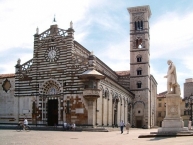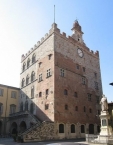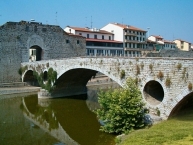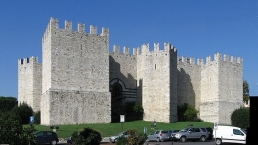Prato Old Town
Worth visiting
Added on 04 Sep 2013,
last edited by »biroto-Redaktion« on 16 Oct 2022
Nearby cycle routes and tours
| Route name | Type | Dist. to route |
|---|---|---|
Route | 0,3 km | |
Tour | 0,0 km | |
Tour | 0,1 km | |
Tour | 0,3 km | |
Tour | 0,3 km | |
Tour | 0,3 km | |
Tour | 0,5 km | |
Tour | 0,9 km |
![]()
Please wait - map data are loading
Type of sights
Old town
Name and address
Prato Old Town
IT-59100 Prato
GEO-data
Geodetic coordinates
43.882206 11.097389
Elevation
64 m
Communication




Prato is a city of 186,710 habitants of Tuscany, immediately to the west of Florence, it is capital of the homonymous province since 1992. The city is famous in Italy and worldwide textile production and the famous biscuit with almonds better known as "cantuccio". In recent decades, Prato, has enjoyed a significant population boom and increased immigration. In fact it is currently the second city of Tuscany, the third of central Italy (after Rome and Florence) and the eighteenth in Italy for its population. Prato and its Province are located in the heart of Tuscany, ideal location to reach the other famous cities in the region. The city and its surrounding area offer interesting and prestigious artistic itineraries, nature and gastronomy. Spend the holidays in Prato means for tourists to dive into the past with an eye towards the future, a journey that goes to contemporary art from the Etruscans.
Understand
Prato is the low-profile cousin of Florence and Pisa in the Central Italy region of Tuscany. Not as mobbed with tourists and without the typical tourist ripoffs it is nonetheless rich with history, art, and great food. It's a great place to stay and save a few dollars while doing day trips to Pisa or Florence.
As regards the area, Prato is a city that is part of the north-east and covers about 100 square km. Located at the foot of the mountain of Retaia, is the highest peak of the town of Prato is the mountain Cantagrilli. The river through meadows and the Bisenzio, a tributary of the Arno.
See
Churches
- ⊙Duomo of Prato (Cathedral of Santo Stefano) (leaving the Piazza of Comune and leaving along the Corso Mazzoni you reach the large Piazza del Duomo). At the large Piazza del Duomo is the Cathedral of Santo Stefano. A splendid example of Romanesque - Gothic Tuscan, the Cathedral is characterized by clever use of two colors on alberese clear and serpentine green marble from Prato, typical materials of town until 1400. On the right side of the front is the famous pulpit, built between 1433 and 1438 by Michelozzo and decorated by Donatello, the pulipito was designed specifically for the Exposition of the Holy Girdle of the Virgin Mary, preserved in the chapel inside the Basilica. Splendidi and precious are the frescoes by Filippo Lippi in the Cappella Maggiore, the famous dance of Salome.
- Bishop's Palace. Adjacent to the cathedral is the Bishop's Palace (XIV-XVII century), part of which is occupied by the Museo dell'Opera del Duomo.
In the territory of Prato, probably since the eighth century, there was a reorganization of the Church with the division into districts that were owned by new churches, the churches (from plebs, the people, namely the community of the baptized), with the baptismal font. The churches listed below are those that were already in medieval churches and are included in the diocese of Prato:
- San Giusto in Piazzanese
- San Lorenzo a Usella
- San Michele a Montecuccoli
- San Pietro a Figline
- San Pietro a Iolo
- San Vito e San Modesto a Sofignano
- Santa Maria a Colonica
- Santa Maria a Filettole
- Sant'Ippolito e San Cassiano
- Sant'Ippolito in Piazzanese
Prato was long known as "City of the Virgin" for the strong Marian devotion that, initially linked to the veneration of the Sacred Belt, then grew with the construction of shrines dedicated to Our Lady (three parishes are today), these are is recently added one dedicated to St. Anthony Mary Pucci.
Monuments
- Fourteenth-century walls. Within these gathered almost all the major historic buildings. The hexagonal circuit of the walls enclosing the original core city of Prato, dotted with ancient tower houses.
- ⊙Castello dell'Imperatore (Emperor's Castle). Fortress, also known as Santa Barbara or Swabian castle, can be considered the most important architectural evidence of centuries XI-XIII.
- Piazza del Comune. Created at the end of the thirteenth century, the intersection of two main roads of the city. In the central area of the square is the Fountain of Bacchino, which was cast in bronze between 1659 and 1665 by Ferdinando Tacca, during the recognition status of city of Prato. In front of City Hall (located in the square) is also found in white Carrara marble statue dedicated to the merchant of Prato, Francesco Datini Antonio Garella (1896).
- ⊙Palazzo Comunale (Town Hall), Piazza del Comune, 2 (overlooking Praetorian Palace), ☎ +39 0574 183622 0.
It was created as the seat of the priors, linking different buildings. Currently it houses the Town Hall. In the hall of the Municipal Council are held two frescoes of the fourteenth century, representing an Allegory of Justice and Majesty. Inside the building are kept several portraits of the Podestà of Prato and the Granduchi of Tuscany. - ⊙Palazzo Pretorio and Museum (Praetorian Palace), Piazza del Comune, ☎ +39 0574 193499 6 or on weekends +39 574 1837860. Mon, Wed-Sun 10:30-18:30 (last admission at 18:00), Tue closed.
The old Town Hall Lawn, located in the town square opposite of the current Town Hall. Since 1912 it houses the Museo Civico. After major restoration works the palace and museum opened again in 2013 to the public. €8. (updated Dec 2015)
- ⊙Palazzo Comunale (Town Hall), Piazza del Comune, 2 (overlooking Praetorian Palace), ☎ +39 0574 183622 0.
- ⊙Datini Palace, Via Ser Lapo Mazzei, 43, ☎ +39 0574 21391.
It was the home of the famous merchant Francesco di Marco Datini (Prato 1335-1410). He leaves an important witness to himself, made up of records and correspondence, which constitute a substantial fund today filed with the State Archives of Prato, which is housed in the old house. - ⊙Sculpture by Henry Moore (Large Square Form with Cut), Piazza San Marco. This is one of many contemporary works of art that the city hosts. The square-shaped cut of the famous contemporary sculptor Henry Moore.
Museums
- ⊙Museo dell'Opera del Duomo. This museum is adjacent to the cathedral and occupies parts of the Bishop's Palace (XIV-XVII century).
- ⊙Museo del Tessuto (Textile museum), Via Puccetti 3, ☎ +39 0574 611503.
- ⊙Museo di pittura murale, Piazza San Domenico 8, ☎ +39 0574 440501.
Sleep
Inside the range of 4 km:
- ⊙ Hotel Giardino, Via Magnolfi, 2/4/6, Prato, PC IV - VII
"... we have not a garage for bikes. But we have on our ground floor a small room where usually we park bikes of our guests."
- ⊙ Hotel San Marco, Piazza San Marco 48, Prato
- ⊙ Hotel Enia, Viale Montegrappa 124, Prato, PC VI - IX
"... we can offer:
• Parking for your bicycles in our private parking lot, which is closed by the gate.
• Tool shed locked with a key.
• If you book a deluxe room (1st floor), on your terrace. However, you need to pay attention to the walls when taking the bikes up the stairs to the 1st floor."Useful
Inside the range of 4 km:
- ⊙ Ufficio Informazioni Turistiche Prato, Piazza del Comune, 8, Prato
Information about copyright
Rights characteristic / license
by-sa: CREATIVE COMMONS Attribution-ShareAlike
Link to the description of the license
Input taken over from:
Wikivoyage contributors, 'Prato', Wikivoyage, The FREE worldwide travel guide that anyone can edit, 8 May 2016, 18:28 UTC, https://en.wikivoyage.org/w/index.php?title=Prato&oldid=2990938
 [accessed 3 September 2016]
[accessed 3 September 2016]taken over / edited on
03 Sep 2016 - 16 Oct 2022
taken over / edited by
Nearby cycle routes and tours
| Route name | Type | Dist. to route |
|---|---|---|
Route | 0,3 km | |
Tour | 0,0 km | |
Tour | 0,1 km | |
Tour | 0,3 km | |
Tour | 0,3 km | |
Tour | 0,3 km | |
Tour | 0,5 km | |
Tour | 0,9 km |
Added on 04 Sep 2013,
last edited by »biroto-Redaktion« on 16 Oct 2022
